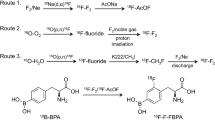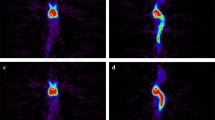Abstract
Purpose
Boramino acids are a class of amino acid biomimics that replace the carboxylate group with trifluoroborate and can achieve the 18F-labeled positron emission tomography (PET) and boron neutron capture therapy (BNCT) with identical chemical structure.
Methods
This study reports a trifluoroborate-derived boronophenylalanine (BBPA), a derived boronophenylalanine (BPA) for BNCT, as a promising PET tracer for tumor imaging.
Results
Competition inhibition assays in cancer cells suggested the cell accumulation of [18F]BBPA is through large neutral amino acid transporter type-1 (LAT-1). Of note, [18F]BBPA is a pan-cancer probe that shows notable tumor uptake in B16-F10 tumor-bearing mice. In the patients with gliomas and metastatic brain tumors, [18F]BBPA-PET shows good tumor uptake and notable tumor-to-normal brain ratio (T/N ratio, 18.7 ± 5.5, n = 11), higher than common amino acid PET tracers. The [18F]BBPA-PET quantitative parameters exhibited no difference in diverse contrast-enhanced status (P = 0.115–0.687) suggesting the [18F]BBPA uptake was independent from MRI contrast-enhancement.
Conclusion
This study outlines a clinical trial with [18F]BBPA to achieve higher tumor-specific accumulation for PET, provides a potential technique for brain tumor diagnosis, and might facilitate the BNCT of brain tumors.




Similar content being viewed by others
Data availability
The datasets generated during and/or analysed during the current study are available from the corresponding author on reasonable request.
Change history
22 March 2024
A Correction to this paper has been published: https://doi.org/10.1007/s00259-024-06678-x
References
Liu Z, Chen H, Chen K, Shao Y, Kiesewetter DO, Niu G, et al. Boramino acid as a marker for amino acid transporters. Sci Adv. 2015;1:e1500694.
Li Z, Kaiser L, Holzgreve A, Ruf VC, Suchorska B, Wenter V, et al. Prediction of TERTp-mutation status in IDH-wildtype high-grade gliomas using pre-treatment dynamic [18F]FET PET radiomics. Eur J Nucl Med Mol Imag. 2021;48:4415–25.
Heinzel A, Stock S, Langen K-J, Müller D. Cost-effectiveness analysis of FET PET-guided target selection for the diagnosis of gliomas. Eur J Nucl Med Mol Imag. 2012;39:1089–96.
Harat M, Rakowska J, Harat M, Szylberg T, Furtak J, Miechowicz I, et al. Combining amino acid PET and MRI imaging increases accuracy to define malignant areas in adult glioma. Nat Commun. 2023;14:4572.
Langen K-J, Watts C. Amino acid PET for brain tumours — ready for the clinic? Nat Rev Neurol. 2016;12:375–6.
Li J, Shi Y, Zhang Z, Liu H, Lang L, Liu T, et al. A metabolically stable Boron-Derived Tyrosine serves as a Theranostic Agent for Positron Emission Tomography guided Boron Neutron capture Therapy. Bioconjug Chem. 2019;30:2870–8.
Lan X, Fan K, Cai W. First-in-human study of an (18)F-labeled boramino acid: a new class of PET tracers. Eur J Nucl Med Mol Imaging. 2021;48:3037–40.
Li Z, Kong Z, Chen J, Li J, Li N, Yang Z, et al. 18F-Boramino acid PET/CT in healthy volunteers and glioma patients. Eur J Nucl Med Mol Imaging. 2021;48:3113–21.
Kong Z, Li Z, Chen J, Ma W, Wang Y, Yang Z, et al. Larger 18F-fluoroboronotyrosine (FBY) active volume beyond MRI contrast enhancement in diffuse gliomas than in circumscribed brain tumors. EJNMMI Res. 2022;12:22.
Weller M, van den Bent M, Preusser M, Le Rhun E, Tonn JC, Minniti G, et al. EANO guidelines on the diagnosis and treatment of diffuse gliomas of adulthood. Nat Rev Clin Oncol. 2021;18:170–86.
Wen PY, Reardon DA. Progress in glioma diagnosis, classification and treatment. Nat Rev Neurol. 2016;12:69–70.
Weller M, Wick W, Aldape K, Brada M, Berger M, Pfister SM, et al. Glioma Nat Rev Dis Primers. 2015;1:15017.
Havu-Aurén K, Kiiski J, Lehtiö K, Eskola O, Kulvik M, Vuorinen V, et al. Uptake of 4-borono-2-[18 F] fluoro-L-phenylalanine in sporadic and neurofibromatosis 2-related schwannoma and meningioma studied with PET. Eur J Nucl Med Mol Imag. 2007;34:87–94.
Nariai T, Ishiwata K, Kimura Y, Inaji M, Momose T, Yamamoto T, et al. PET pharmacokinetic analysis to estimate boron concentration in tumor and brain as a guide to plan BNCT for malignant cerebral glioma. Appl Radiat Isot. 2009;67:348–S50.
Louis DN, Perry A, Wesseling P, Brat DJ, Cree IA, Figarella-Branger D, et al. The 2021 WHO classification of tumors of the Central Nervous System: a summary. Neuro Oncol. 2021;23:1231–51.
Kong Z, Li Z, Chen J, Liu S, Liu D, Li J et al. Metabolic characteristics of [18F]fluoroboronotyrosine (FBY) PET in malignant brain tumors. Nucl Med Biol. 2022;106–7:80–7.
Kong Z, Zhang Y, Liu D, Liu P, Shi Y, Wang Y, et al. Role of traditional CHO PET parameters in distinguishing IDH, TERT and MGMT alterations in primary diffuse gliomas. Ann Nucl Med. 2021;35:493–503.
Chen J, Li C, Hong H, Liu H, Wang C, Xu M, et al. Side chain optimization remarkably enhances the in vivo stability of 18F-labeled glutamine for tumor imaging. Mol Pharm. 2019;16:5035–41.
Wollring MM, Werner J-M, Ceccon G, Lohmann P, Filss CP, Fink GR, et al. Clinical applications and prospects of PET imaging in patients with IDH-mutant gliomas. J Neurooncol. 2023;162:481–8.
Rozenblum L, Zaragori T, Tran S, Morales-Martinez A, Taillandier L, Blonski M, et al. Differentiating high-grade glioma progression from treatment-related changes with dynamic [18F]FDOPA PET: a multicentric study. Eur Radiol. 2023;33:2548–60.
Lapointe S, Perry A, Butowski NA. Primary brain tumours in adults. Lancet. 2018;392:432–46.
Bi JF, Chowdhry S, Wu SH, Zhang WJ, Masui K, Mischel PS. Altered cellular metabolism in gliomas - an emerging landscape of actionable co-dependency targets. Nat Rev Cancer. 2020;20:57–70.
Kim MM, Parolia A, Dunphy MP, Venneti S. Non-invasive metabolic imaging of brain tumours in the era of precision medicine. Nat Rev Clin Oncol. 2016;13:725–39.
Dhermain FG, Hau P, Lanfermann H, Jacobs AH, van den Bent MJ. Advanced MRI and PET imaging for assessment of treatment response in patients with gliomas. Lancet Neurol. 2010;9:906–20.
Kaschten B, Stevenaert A, Sadzot B, Deprez M, Degueldre C, Del Fiore G, et al. Preoperative evaluation of 54 gliomas by PET with fluorine-18-fluorodeoxyglucose and/or carbon-11-methionine. J Nucl Med. 1998;39:778–85.
Deuschl C, Kirchner J, Poeppel TD, Schaarschmidt B, Kebir S, El Hindy N, et al. (11)C-MET PET/MRI for detection of recurrent glioma. Eur J Nucl Med Mol Imaging. 2018;45:593–601.
Nodwell MB, Yang H, Čolović M, Yuan Z, Merkens H, Martin RE, et al. 18F-Fluorination of Unactivated C–H bonds in branched aliphatic amino acids: direct synthesis of Oncological Positron Emission Tomography Imaging agents. J Am Chem Soc. 2017;139:3595–8.
Hutterer M, Nowosielski M, Putzer D, Jansen NL, Seiz M, Schocke M, et al. [18F]-fluoro-ethyl-L-tyrosine PET: a valuable diagnostic tool in neuro-oncology, but not all that glitters is glioma. Neuro Oncol. 2013;15:341–51.
Grosu AL, Astner ST, Riedel E, Nieder C, Wiedenmann N, Heinemann F, et al. An interindividual comparison of O-(2-[18F]fluoroethyl)-L-tyrosine (FET)- and L-[methyl-11 C]methionine (MET)-PET in patients with brain gliomas and metastases. Int J Radiat Oncol Biol Phys. 2011;81:1049–58.
Galldiks N, Niyazi M, Grosu AL, Kocher M, Langen KJ, Law I, et al. Contribution of PET imaging to radiotherapy planning and monitoring in glioma patients - a report of the PET/RANO group. Neuro Oncol. 2021;23:881–93.
Hanaoka K, Watabe T, Naka S, Kanai Y, Ikeda H, Horitsugi G, et al. FBPA PET in boron neutron capture therapy for cancer: prediction of 10B concentration in the tumor and normal tissue in a rat xenograft model. EJNMMI Res. 2014;4:70.
Miyatake S, Kawabata S, Yokoyama K, Kuroiwa T, Michiue H, Sakurai Y, et al. Survival benefit of Boron neutron capture therapy for recurrent malignant gliomas. J Neurooncol. 2009;91:199–206.
Linz U. Boron neutron capture therapy for glioblastoma: is it worth pursuing? Technol Cancer Res Treat. 2008;7:83–8.
Funding
This study was funded by National Natural Science Foundation of China (Grant No. 22225603), Ministry of Science and Technology of the People’s Republic of China (Grant No. 2021YFA1601400), Beijing Municipal Natural Science Foundation (Grant No. Z200018), and Changping Laboratory to Zhibo Liu, Science Foundation of Peking University Cancer Hospital (Grant No. PY202309) to Zhu Li, Beijing Municipal Natural Science Foundation (Grant No.7232351), Special Research Fund for Central Universities, and Peking Union Medical College (Grant No. 3332022024), and National Natural Science Foundation of China (Grant No. 32301152) to Ziren Kong, and the National High Level Hospital Clinical Research Funding(Grant No. 2022-PUMCH-A-019) to Yu Wang. We thank the facility support from the Analytical Instrumentation Center of Peking University.
Author information
Authors and Affiliations
Contributions
Zhibo Liu and Yu Wang conceived the study; Junyi Chen performed material synthesis, characterization and chemical analysis; Zhu Li, Junyi Chen and Yixin Shi assisted by Mengxin Xu performed most of the experiments; Nan Li, Wenbin Ma, Bo-Shuai Mu and Zhi Yang provided technical assistance and suggestions. Yu Wang, Zhi Yang, Ziren Kong and Zhibo Liu analysed the data. Ziren Kong, Junyi Chen and Zhibo Liu wrote the manuscript with input from all authors. All authors discussed the results and commented on the manuscript.
Corresponding authors
Ethics declarations
Ethics approval
This study was performed in line with the principles of the Declaration of Helsinki, approved by the Institutional Review Board of the Peking University Cancer Hospital (ID 2021KT38), and registered at clinicaltrials.gov (NCT05987098). Written informed consent was obtained from all participants.
Competing Interests
Junyi Chen, Mengxin Xu, and Zhibo Liu are consultants of Boomray Pharmaceuticals (Beijing) Co., Ltd. No other potential conflicts of interest relevant to this article exist.
Additional information
Publisher’s Note
Springer Nature remains neutral with regard to jurisdictional claims in published maps and institutional affiliations.
The authors regret that the version of Figure 3 that appears in the original published article is incorrect. The correct and incorrect versions of the figure is provided in the erratum article.
The original article has been corrected.
Electronic supplementary material
Below is the link to the electronic supplementary material.
Rights and permissions
Springer Nature or its licensor (e.g. a society or other partner) holds exclusive rights to this article under a publishing agreement with the author(s) or other rightsholder(s); author self-archiving of the accepted manuscript version of this article is solely governed by the terms of such publishing agreement and applicable law.
About this article
Cite this article
Li, Z., Chen, J., Kong, Z. et al. A bis-boron boramino acid PET tracer for brain tumor diagnosis. Eur J Nucl Med Mol Imaging 51, 1703–1712 (2024). https://doi.org/10.1007/s00259-024-06600-5
Received:
Accepted:
Published:
Issue Date:
DOI: https://doi.org/10.1007/s00259-024-06600-5




